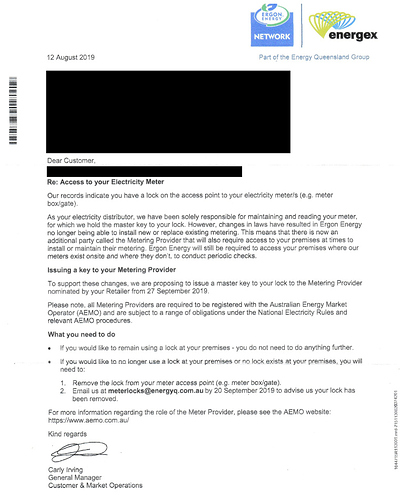Some years ago when our elder daughter and her family were living in one of their former Cairns properties, some scumbag turned the main switch off in the meter box in the middle of the night.
Fortunately, her husband was at home and he turned the power back on, but after they moved to live at a mine site in Sumbawa, our younger daughter was living in the same house by herself when the same thing occurred.
I ordered Ergon padlocks from their monopoly locksmith supplier for that house and our own home and I installed secure hook and staple fittings to both meter boxes and put a stop to any further occurrences
When we bought our current home in 2015, I immediately bought another Ergon padlock and a secure hook and staple fastener, and I installed it on our meter box.
The padlocks have a restricted master key system whereby the property occupant has 2 slave keys and Ergon and their meter readers have a master key which works with all meter boxes with an Ergon padlock.
If you want to help protect yourself and your family from scumbags who may range from idiots wishing to spoil your night through to grubs planning far more nefarious activities, I would highly recommend that you lock your meter box if your residential situation allows you to do so.
Our neighbours at our former home related the experience of the home owner on the other side of their home.
When their fancy washing machine they had bought from Harvey Norman displayed an alarm, they called the store, and when they told the salesperson the fault code it was displaying, he advised them that their water supply had been turned off and they were about to be robbed.
Some scumbag had reached through their remote-controlled gate to turn off the valve at the water meter which was located behind their high masonry block fence.
Apparently, these grubs turn off the water supply and then return an hour or so later to check if it is still turned off. If it is, they assume there is nobody home.
Another grubby act is turning off the power to the pool pump and chlorinator and then returning some days later to see if the pool has turned green. If it has, they assume the residents are away.

